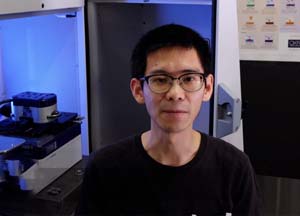 Mechanical friction leads to wear and energy dissipation, and its control is of high importance in new-generation miniature electromechanical devices. 2D materials such as graphene are considered to be excellent solid lubricants due to their ultralow friction and have attracted considerable research interest. Unique friction properties are discovered in various other 2D materials. However, the friction of functional van der Waals materials which have potential applications in novel nanoelectronics, like ferroelectric copper indium thiophosphate, has barely been studied. Herein, the study reports on the observation of inhomogeneous friction behavior existing in copper-deficient CuInP2S6 (Cu0.2In1.26P2S6), which exhibits a nanoscale phase separation of polar and non-polar crystalline phases. The paraelectric In4/3P2S6 phase exhibits higher friction than the ferroelectric CuInP2S6 phase, while phase boundaries between the two phases, interestingly, display the lowest friction. The origin of this phenomenon is attributed to different lattice strains of phases together with the presence of large strains at the nanoscale phase boundaries, which also manifests in the nonuniform tip-sample adhesion force. The findings provide new insights into nanoscale device design and wear behavior of a phase-separated van der Waals ferroelectric, which may help to reduce the power consumption of friction-exhibiting devices and extend their service life.
Mechanical friction leads to wear and energy dissipation, and its control is of high importance in new-generation miniature electromechanical devices. 2D materials such as graphene are considered to be excellent solid lubricants due to their ultralow friction and have attracted considerable research interest. Unique friction properties are discovered in various other 2D materials. However, the friction of functional van der Waals materials which have potential applications in novel nanoelectronics, like ferroelectric copper indium thiophosphate, has barely been studied. Herein, the study reports on the observation of inhomogeneous friction behavior existing in copper-deficient CuInP2S6 (Cu0.2In1.26P2S6), which exhibits a nanoscale phase separation of polar and non-polar crystalline phases. The paraelectric In4/3P2S6 phase exhibits higher friction than the ferroelectric CuInP2S6 phase, while phase boundaries between the two phases, interestingly, display the lowest friction. The origin of this phenomenon is attributed to different lattice strains of phases together with the presence of large strains at the nanoscale phase boundaries, which also manifests in the nonuniform tip-sample adhesion force. The findings provide new insights into nanoscale device design and wear behavior of a phase-separated van der Waals ferroelectric, which may help to reduce the power consumption of friction-exhibiting devices and extend their service life.
About the presenter
Dawei Zhang Research Fellow at UNSW with CI Jan Seidel. His research focusse on scanning probe microscopy studies of ferroelectric and multiferroic thin films, and domain wall engineering to explore novel concepts for applications and storage, working within FLEET’s Research Theme 1, Topological Materials.
